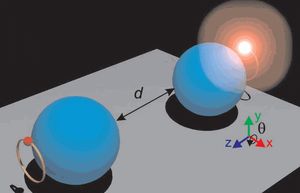



Date:29/01/16
 A team of researchers led by Polina Kapitanova at ITMO University and Elizaveta Nenasheva at Giricond Research Institute, both in Saint Petersburg, Russia, have proposed a new wireless power transfer (WPT) system.
A team of researchers led by Polina Kapitanova at ITMO University and Elizaveta Nenasheva at Giricond Research Institute, both in Saint Petersburg, Russia, have proposed a new wireless power transfer (WPT) system.
According to numerical simulations, their proposed system can maintain an 80-percent transfer efficiency across a distance of 20 centimeters, while experiencing only a very small decrease in the efficiency as the distance increases.
Although wireless power transfer (WPT) was famously pioneered by Tesla in the early 20th century, it was not until 2007 that a team of scientists from MIT demonstrated the feasibility of WPT (or "WiTricity"), by powering a 60-watt light bulb from a distance of two meters at 45% transfer efficiency.
In the new research, the researchers demonstrated that they could decrease power loss — and therefore increase efficiency — in WPT systems in two ways. First, they replaced the traditional copper coils with high-permittivity low-loss dielectric resonators, which look like two ceramic spheres. These resonators have a high refractive index, meaning that an electromagnetic wave traveling through them is greatly slowed down. For WPT, this property translates to stronger magnetic resonances in the ceramic spheres, and stronger resonances lead to higher efficiencies.
Scientists propose high-efficiency wireless power transfer system
 A team of researchers led by Polina Kapitanova at ITMO University and Elizaveta Nenasheva at Giricond Research Institute, both in Saint Petersburg, Russia, have proposed a new wireless power transfer (WPT) system.
A team of researchers led by Polina Kapitanova at ITMO University and Elizaveta Nenasheva at Giricond Research Institute, both in Saint Petersburg, Russia, have proposed a new wireless power transfer (WPT) system.According to numerical simulations, their proposed system can maintain an 80-percent transfer efficiency across a distance of 20 centimeters, while experiencing only a very small decrease in the efficiency as the distance increases.
Although wireless power transfer (WPT) was famously pioneered by Tesla in the early 20th century, it was not until 2007 that a team of scientists from MIT demonstrated the feasibility of WPT (or "WiTricity"), by powering a 60-watt light bulb from a distance of two meters at 45% transfer efficiency.
In the new research, the researchers demonstrated that they could decrease power loss — and therefore increase efficiency — in WPT systems in two ways. First, they replaced the traditional copper coils with high-permittivity low-loss dielectric resonators, which look like two ceramic spheres. These resonators have a high refractive index, meaning that an electromagnetic wave traveling through them is greatly slowed down. For WPT, this property translates to stronger magnetic resonances in the ceramic spheres, and stronger resonances lead to higher efficiencies.
Views: 598
©ictnews.az. All rights reserved.Similar news
- The mobile sector continues its lead
- Facebook counted 600 million active users
- Cell phone testing laboratory is planned to be built in Azerbaijan
- Tablets and riders outfitted quickly with 3G/4G modems
- The number of digital TV channels will double to 24 units
- Tax proposal in China gets massive online feedback
- Malaysia to implement biometric system at all entry points
- Korea to build Green Technology Centre
- Cisco Poised to Help China Keep an Eye on Its Citizens
- 3G speed in Azerbaijan is higher than in UK
- Government of Canada Announces Investment in Green Innovation for Canada
- Electric cars in Azerbaijan
- Dominican Republic Govt Issues Cashless Benefits
- Spain raises €1.65bn from spectrum auction
- Camden Council boosts mobile security





















